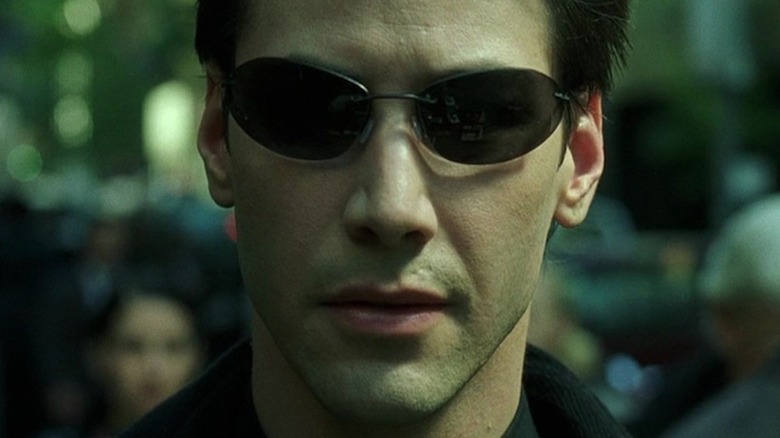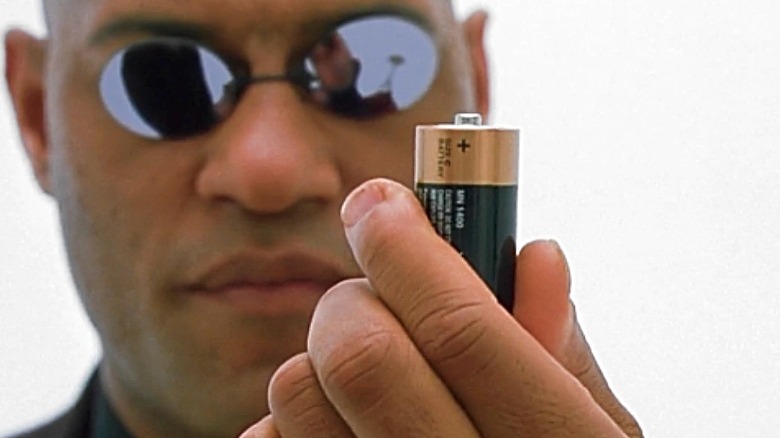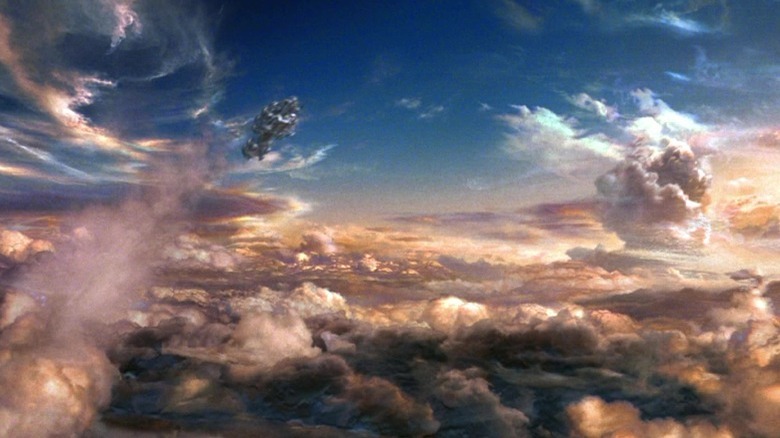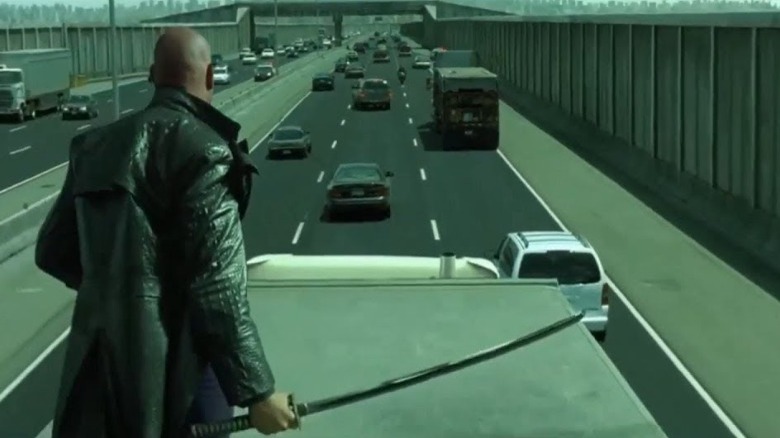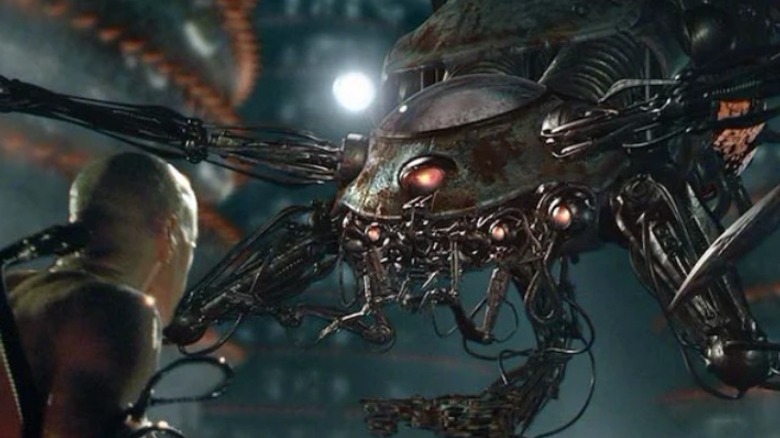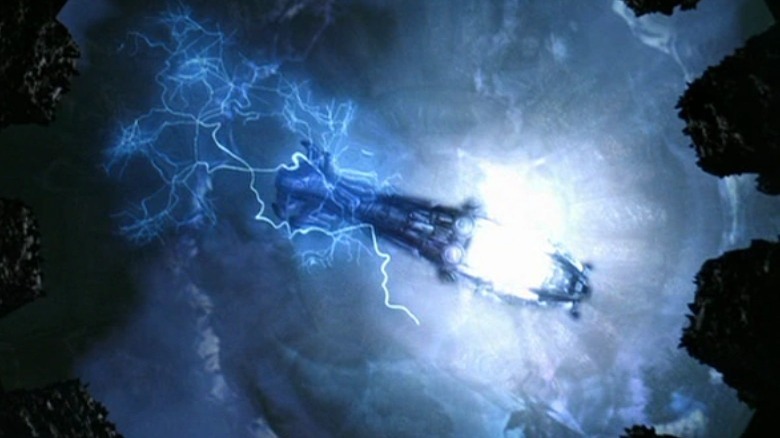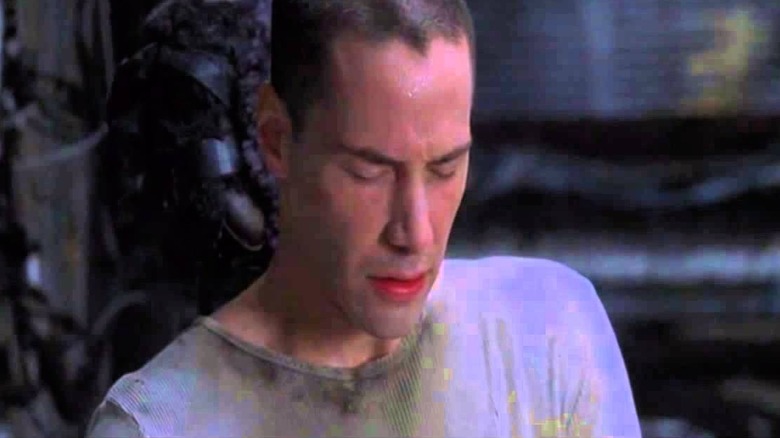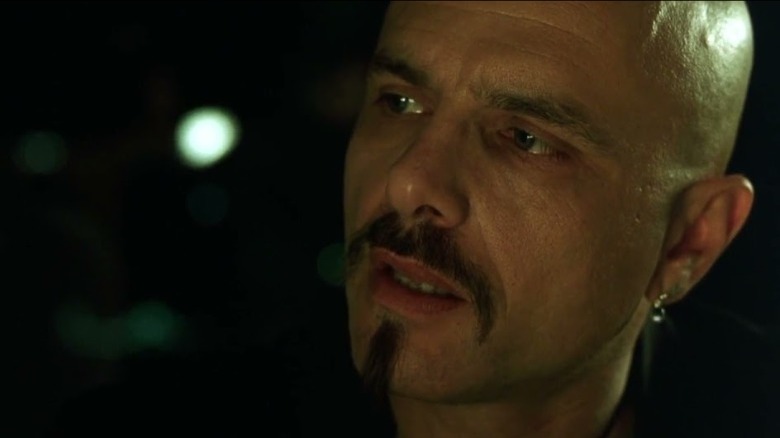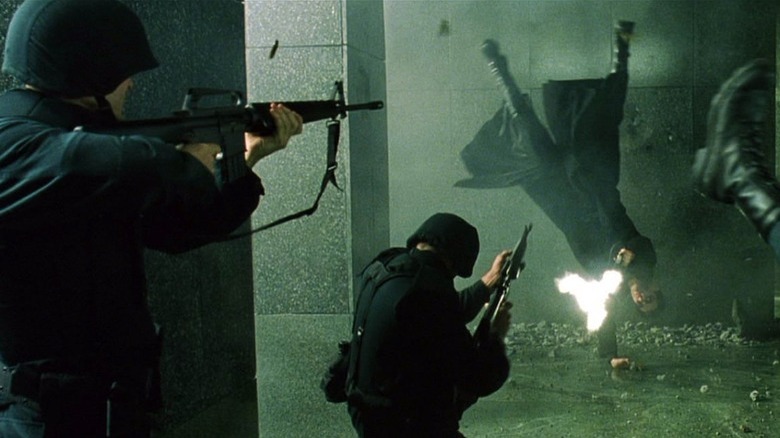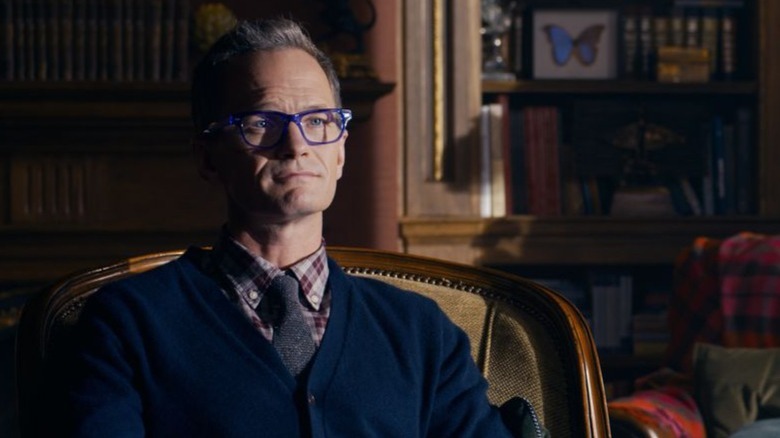Plot Holes From The Matrix Franchise That Still Need Some Explaining
1999's "The Matrix" was a smash hit that became part of movie history. This seminal sci-fi film explores philosophical themes and poses interesting questions about the nature of our reality. It follows Neo (Keanu Reeves) on his journey to free humanity from a terrible fate — almost everyone is unknowingly trapped in a simulation created by machines. The success of the movie quickly led to two sequels, spin-off comics, and some video games, as well as a belated fourth film in 2021, "The Matrix Resurrections."
As interesting and compelling as the story of the original film is, it wasn't perfect. It had its own internal narrative problems and some plot holes that bugged fans. The addition of the sequels and the likes of "The Animatrix" only amplified this, adding more material to a world that could already be difficult to comprehend. There are some major plot holes that simply don't make sense, many of which still need explaining. These are the most confusing of the bunch. Spoilers ahead.
Humans couldn't actually provide that much energy
The fictional history of "The Matrix" is complicated and long, with important events taking place a long time before the first film. During this time, humans and machines fought a long war that eventually led to the near destruction of humankind. At this point, the machines effectively enslaved humans and, as explained by Morpheus in the original movie, turned them into a power source to provide energy. This is one of the biggest plot holes in the series, as it turns out that people simply don't make very good batteries.
According to SyFy, the problem with using humanity as a producer of energy is that the energy required to keep people alive in their pods would make the whole process counterproductive. The produced energy would be so insignificant that it wouldn't be useful, even with billions of enslaved humans. It simply isn't an efficient way to acquire the energy needed to provide power for all of the machines' needs. In fact, scientist Robert Hurt told Esquire that simply burning the food used to feed the enslaved people would be much more energy efficient.
"You can chalk it up to thermodynamics and entropy; some systems just don't process efficiently and basically you can count on getting less energy out than you put in," Hurt said. There have been suggestions that humans were initially meant to be a source of computational processing power for the machines, acting as a sort of cloud computing solution, making them more like a CPU than a battery. However, there's little evidence to back up this point.
Why didn't the machines just use solar panels?
In the same war that led to humanity getting enslaved by machines, another important event was the scorching of the sky. A last-ditch effort by the human governments to deprive the machines of their main power source of solar energy, it was known as Operation Dark Storm. The plan was to spray nanites across Earth's atmosphere, covering the sky in a shroud that would allow no light to reach the surface. The mission was a success, but the machines were able to adapt to the situation and eventually used a combination of human power and fusion to produce the energy they required.
The plot hole comes from the fact that Neo and Trinity can fly through this shroud in the Logos as they attempt to reach the machine city and put a stop to Smith and the destruction of Zion. Being attacked by many sentinels and bombarded by the city's defenses, they rise above the clouds and get a glimpse at the sky as it should be, bathed in sunlight.
This begs the question of why the machines needed to develop fusion power or the Matrix to begin with, as all of the energy they would ever need was still available above this shroud. Considering the technological achievements of the machines, it does not seem out of the realm of possibility that they could have developed large towers with solar panels to capture sunlight.
The Matrix is obvious, so why can't more people see it?
The entire premise of "The Matrix" revolves around the idea that 99% of all humans are trapped in a simulated reality that they don't realize is not the real world. They only remain part of the virtual world as long as they accept it, but far more people should be aware that the Matrix isn't real as there are far too many inconsistencies within this computer simulation.
For example, much of the action takes place within a location known only as Mega City and contains companies and places with highly generic names. Then there's the fact that the world is seemingly stuck in the year 1999, with no advancement or technological achievements happening. Time stands still at what the machines consider to be the peak of human civilization. The Matrix also has a strange green tint to it, and possessions — when an agent takes over the body of a so-called bluepill — are completely ignored, as is the mass devastation routinely caused by Morpheus and his group.
Various comics and spin-offs of "The Matrix" franchise, such as "The Animatrix," do mention a process known as self substantiation, whereby people can suddenly become aware that they are living in a simulation. They do this without help from outside sources, such as redpills, and are usually highly intelligent or talented. These people notice the inconsistencies mentioned above and see the Matrix for what it really is, but this shouldn't be a rare skill limited to just a few, as it is pretty obvious that there is something wrong with the Matrix.
Why don't the machines kill anyone who wakes up?
Neo and the viewers first see the real world in "The Matrix" when the protagonist takes the red pill and wakes up from the simulation. He emerges in a pod of liquid covered in wires, tubes, and probes, witnessing the truth of what the machines have done by enslaving humanity and forcing them to live in pods as an energy source. The protagonist is then disconnected from the pod and sent down a sewer, where Morpheus and the rest of the crew of the Nebuchadnezzar are able to rescue him.
Many people have wondered why the machines allow those who have escaped from the Matrix to leave. The Agents seem determined to stop Morpheus and the others from carrying out their mission and try to stop Neo from leaving the simulation, but once he has escaped, he's not immediately killed. It's clear that the machines are aware of those who take the red pill, as a docbot quickly comes over to Neo to remove his connections and flush him away.
Some fans try to explain this away by saying that the docbot was attempting to get rid of Neo by flushing him into the sewer, where he would have drowned if Morpheus had not located and saved him in time. The machine simply doesn't follow up on what has happened to those it has disposed of, as that is its only purpose. But this explanation still doesn't give any insight into why the machines are seemingly perfectly happy to allow people to escape without any tracking or obstruction.
How did the machines survive the nuclear bombardment?
As previously mentioned, humanity and the machines fought a catastrophic war before the events of "The Matrix," which led to the enslavement of mankind. During this war, the UN made a pre-emptive strike against the machine city of 01, hitting it with a nuclear bombardment that they hoped would level the city and destroy every machine. These events are shown during the first two parts of "The Animatrix." The machines are said to have survived as they were more resistant to the heat and radiation given off by the nukes than humans anticipated.
As noted by Redditor u/snopuppy, this is a pretty big plot hole for the series as a whole. While it is understandable that the machines, made of synthetic material, would be better able to withstand these effects compared to humans, the nuclear weapons would pose a threat to the machines in one crucial way: Nuclear explosions cause electromagnetic pulses. Considering the sheer number of nuclear bombs dropped on 01 during the attack, the EMP blast should have wiped out every electronic device for many miles.
"The Matrix" and its sequels even show that EMP blasts are effective against machines. Each hovercraft is equipped with an EMP to use as a last resort in case it is overwhelmed, and a larger EMP destroys the first sentinel army attacking Zion. But how the machines managed to survive the EMP given off by the nuclear bombardment is never addressed or explained.
How does the brain make injuries in the Matrix real?
Early on in "The Matrix," both Neo and the viewers learn that, despite the Matrix being a simulation, events that happen inside the virtual world can have an effect on the person in the real world. Neo experiences injuries upon waking up from training and questions how this has happened if the Matrix isn't real. Morpheus responds by saying, "Your mind makes it real," adding that "the body cannot live without the mind." Flimsy? You bet.
There's no real revelation about how a person's brain can cause them physical harm, including things like coughing up blood or suffering pain from impacts. While our brains can make us feel aches and pains that weren't caused by actual physical harm, there is no evidence to suggest that they would be able to mimic injuries such as broken bones or death. In that sense, the explanation that the simulation is so realistic that people couldn't differentiate between a real or fake death just doesn't fly.
All of this means that people who die when connected to the Matrix shouldn't die outside of the Matrix at the same time. They certainly shouldn't suffer any genuine injuries or actually bleed due to damage they take while in the simulation, as is shown in the films. While your brain might trick you into feeling phantom pains when you're injured in the simulation, dying in the Matrix really ought to equate to nothing more than waking up from a bad dream.
How come Neo can move when he's unplugged?
According to what we have seen of the humans who are connected to the Matrix in the films and "The Animatrix," they are kept in a motionless state in the pods that house them. It appears as if they are sleeping or in a sort of coma to stop them from acting out what they are experiencing, in much the same way as the brain will temporarily paralyze your body while you dream to ensure it doesn't injure itself while you are asleep. What this means for the enslaved people is that they are getting no exercise at all, as they don't physically move.
If this is the case then you would expect that people within the Matrix would suffer from extreme muscle atrophy. Even worse, in most cases, these muscles would be completely underdeveloped as they have never been used before and have had no chance to grow or gain strength. When Neo awakens, he should have been unable to move any of his limbs, never mind thrashing around in the water when he is first dropped into the sewer.
Almost immediately after coming aboard Morpheus's ship, Neo is seen walking around and moving his body in a way that shouldn't be possible after decades of lying still. While he does show some distress and pain in his early moments after being awoken from the Matrix, it is nowhere near as difficult as it should be. It ought to have taken many months to fully recover from such a long period in the pod, making this another gaping plot hole.
How does Cypher get in and out of the Matrix alone?
Although Cypher is part of Morpheus' team on board the Nebuchadnezzar and seemingly an ally of Neo and humanity, it later turns out that not everything is as it seems. The truth is that Cypher has betrayed his crew and has been working with Agent Smith to capture Morpheus so that Cypher can be permanently plugged back into the Matrix because he is tired of the hard life those outside the simulation have to endure. At one point during the first film, Cypher is even shown meeting with Agent Smith in a restaurant.
It is this meeting that poses the real problem for the plot, as it is never revealed how Cypher jacks into the Matrix alone. Every time viewers see someone entering the Matrix they do so with the help of an operator. These people not only provide guidance and support to those in the simulation, but they also play an essential part in extracting them from the Matrix. The film never explains how Cypher was able to get in and out of the virtual world unaided. It is clear that he is working alone as he is forced to incapacitate the crew to carry out his plan in a later scene, so this represents yet another plot hole.
There are other issues with this part of the story. For instance, how did he conceal what he was doing and confirm that he wouldn't be disturbed while in the Matrix? He would have been oblivious to what was happening in the real world while jacked in. What's more, the hovercrafts used by the redpills have to climb quite high in order to reach a suitable broadcast point where they can hack into the Matrix. Surely someone on the Nebuchadnezzar would have noticed the ship moving for no apparent reason?
Morpheus and his gang are willing to kill other humans
The goal of Morpheus and everyone else in Zion is to not only survive but to defeat the machines and free the people enslaved within the Matrix. It is a noble goal and one that Neo quickly subscribes to — after all, who wouldn't want to save their fellow humans if given the chance? Yet, in their efforts to do just that, the freed humans are more than willing to kill as many people as it takes. As discussed earlier, those killed in the Matrix are also killed in real life, so Neo, Trinity, and the rest of the gang are genuinely murdering innocent people every time they enter the Matrix.
Morpheus attempts to justify this when explaining the Matrix to Neo by suggesting that plugged-in humans are the enemy until they are unplugged. He tells Neo: "Businessmen, teachers, lawyers, carpenters. The very minds of the people we are trying to save. But until we do, these people are still a part of that system and that makes them our enemy. You have to understand, most of these people are not ready to be unplugged. And many of them are so inured, so hopelessly dependent on the system, that they will fight to protect it."
He is essentially arguing that the ends justify the means, but this is not a moral framework that most people would agree with. The greater good doesn't mean you can just slaughter as many people as you want, and Morpheus and his crew kill a lot of people — there are at least 43 confirmed deaths in the first movie alone.
The Analyst gives himself away
"The Matrix Resurrections" continues the story of the original trilogy some 60 years after the defeat of Agent Smith and the apparent death of Neo and Trinity. What came next was a truce between machines and humanity that allowed any person wishing to leave the Matrix to do so. Meanwhile, the new leader of the Matrix, the Analyst, resurrected both Neo and Trinity in an attempt to study them and learn of a way to exert further control over those in the simulation.
Thomas Anderson — or Neo to those aware of his true self — is a video game developer who designed a game known as "The Matrix" and is haunted by memories of his past life. His therapist, who is secretly the Analyst, tries to convince Neo that these are not memories but delusions. However, in one conversation he gives away that he knows more than he should and creates a plot hole that is never addressed.
Neo only started seeing the therapist in the simulation when he tried to take his own life, and it is shown that this happens when he was celebrating the success of the game. Yet, the Analyst later says that Neo took parts of his own life and inserted them into the game to make it more realistic, including Neo's hatred of the Analyst's pet cat. This shouldn't have been possible as Neo would have only met the Analyst and his cat after the game had already launched.
If you or someone you know is struggling or in crisis, help is available. Call or text 988 or chat 988lifeline.org
